A little good-natured rivalry is good for business. As long as you maintain focus on your own vision and principles, keeping an ear out for what the other firm is doing can motivate you to work smarter, innovate — and perhaps even stumble upon the occasional, mutually rewarding collaboration.
But the one time it really hurts is when a rival firm headhunts your best people. Talent is personal: leaders are invested in identifying potential stars, finding the right role for them and developing their skills, getting to know the human inside along the way. It isn’t good to see them go.
Conversely, while losing people to a rival feels awful, attracting talent from other companies is rewarding. You believe you have something to offer and a vision to develop together. And if that gives you an edge over your competitors? Well, it just motivates them to work smarter, too!
The tech giants are masters at this. They understand that whatever their product or service, the real machinery that makes the magic happen is the people they employ to imagine and build it. They can offer demanding challenges, handsome rewards and glowing prestige to attract this talent from schools, smaller companies and — very often — those fellow tech giants who take their eyes off the ball.
But small businesses can also compete in this arena. Today’s talents don’t just care about money on the table; they want growth, flexibility and recognition. These are personal touches that may be easier to deliver at a smaller firm. And they want a voice, some responsibility. Again, it is easier to make a splash in a small business.
To give an idea of the paths that top talents tend to take through some of the biggest companies, we identified the tech giants that attract the most talent from their competitors — and where that talent goes next.
What We Did
Switch On Business analyzed LinkedIn employee profiles for Google (Alphabet), Amazon, Apple, Meta, Microsoft, IBM, Tesla, Oracle, Netflix, Nvidia, Salesforce, Adobe, Intel and Uber. We highlighted the employees who currently work in each tech giant and previously worked for one of the others. This allowed us to calculate the number and percentage of employees who’ve moved from each of these companies to another.
KEY FINDINGS
- Some 26.51% of Meta employees have worked at another tech giant — the highest proportion of any tech giant workforce.
- However, Google has attracted the most talent by volume: 38,316 (24.15%) of their current staff came via other tech giants.
- IBM headhunts the least, with just 2.28% of the current workforce having previously worked for another tech giant.
One Quarter of Meta’s Workforce Came from Other Tech Giants
Meta is the king of the headhunters — the only big tech company where more than a quarter of the workforce has previously worked for a rival tech giant. Talent recruitment and retention is a complex operation at the Facebook company. “Throughout the hiring lifecycle, the recruiting team collaborates cross-functionally with various teams,” explains Meta recruiting manager Joanne K., “like the candidate experience team, diversity and people partners— who help ensure candidates have the best experiences, and that inclusivity and diversity are always top of mind.”
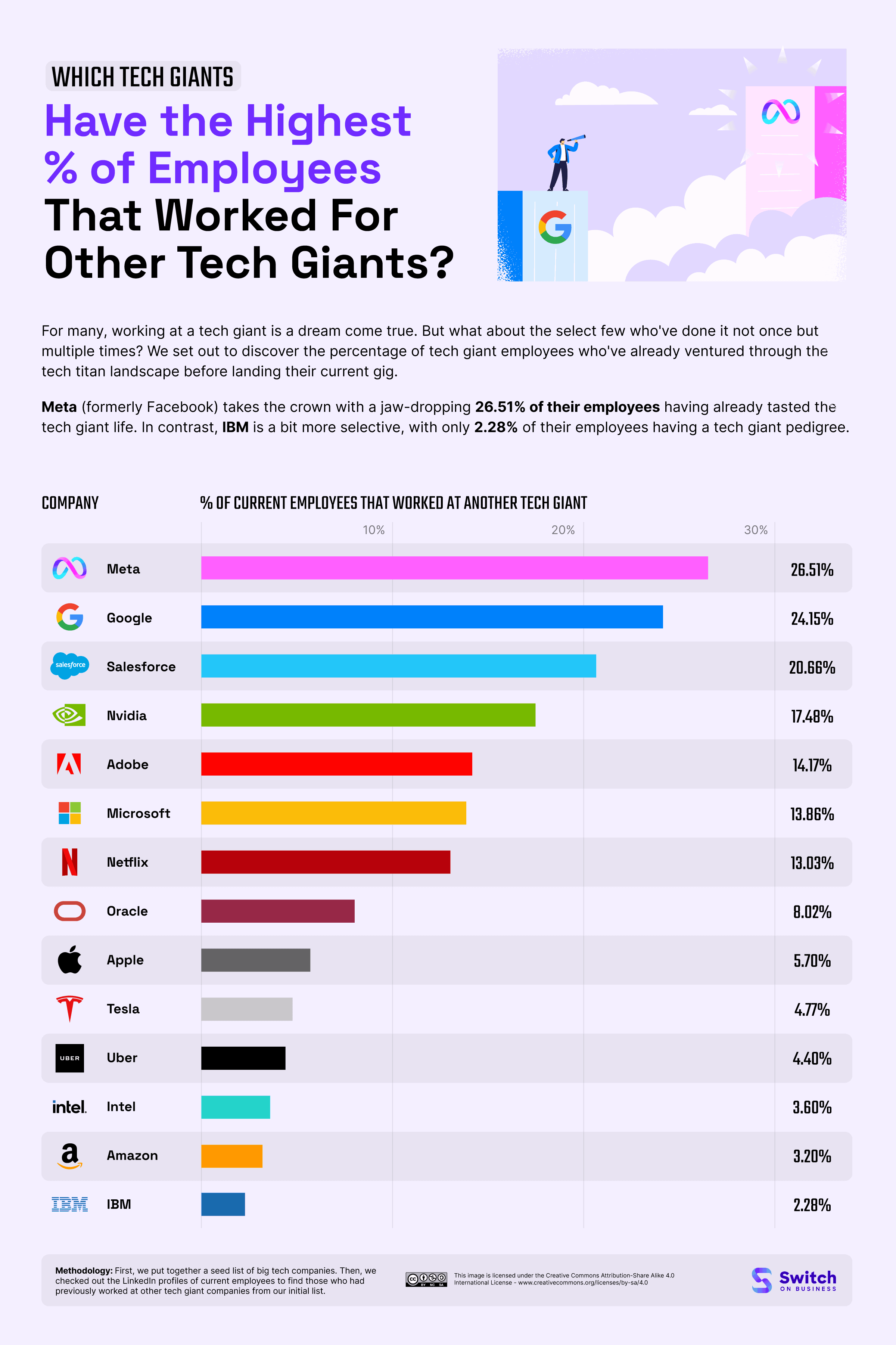
Click here to see the image in full size
However, Meta has a relatively small workforce. Google has only a slightly lower proportion of tech giant veterans (24.15%), but with a significantly larger workforce, that adds up to 38,316 employees who’ve previously worked for another tech giant. The company’s recruitment process is notoriously thorough, with an entire hiring committee needing to give the thumbs-up to a potential recruit. “They’re like a layer of objectivity and they’re looking to see does this person match the qualification for this immediate role at hand,” says the company’s Global Recruiting Manager, Lisa Haynes. “Also, are they gonna be a good fit for the organization as a whole for the longer term[?]”
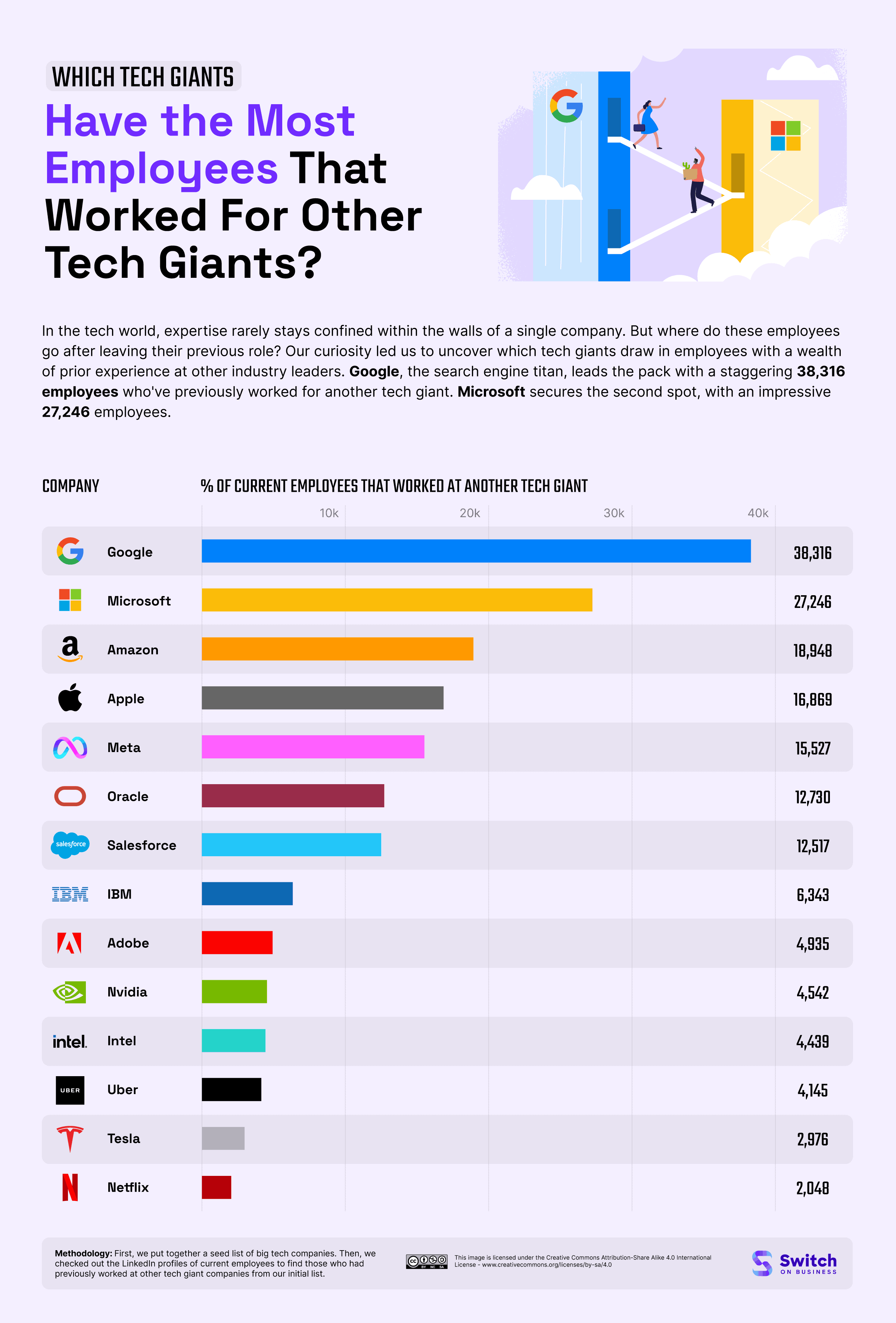
Click here to see the image in full size
IBM has one of the biggest workforces on the list but relatively few ex-big tech recruits (2.28% or 6,343). A key reason for this is IBM’s focus on developing skills in-house — more than 90% of the company’s apprentices go on to become full-time employees, according to the company. IBM also provides skills development opportunities for high school students from underserved backgrounds through its P–TECH public education program. These strategies go along with another recruitment policy that broadens the pool beyond top tech giant talent: for some time, IBM has considered a college degree to be non-essential.
“As a result of the way we were writing descriptions, we were essentially limiting our applicant pool and making diversity and inclusion a lot more challenging,” Obed Louissaint, IBM’s former SVP of transformation and culture, told HRD. “By being really specific on what it is you need versus putting in dumb barriers, you increase the applicant pool and have a better shot at having a more inclusive and skilled workforce.”
Amazon Recruits Very Few Tech Veterans
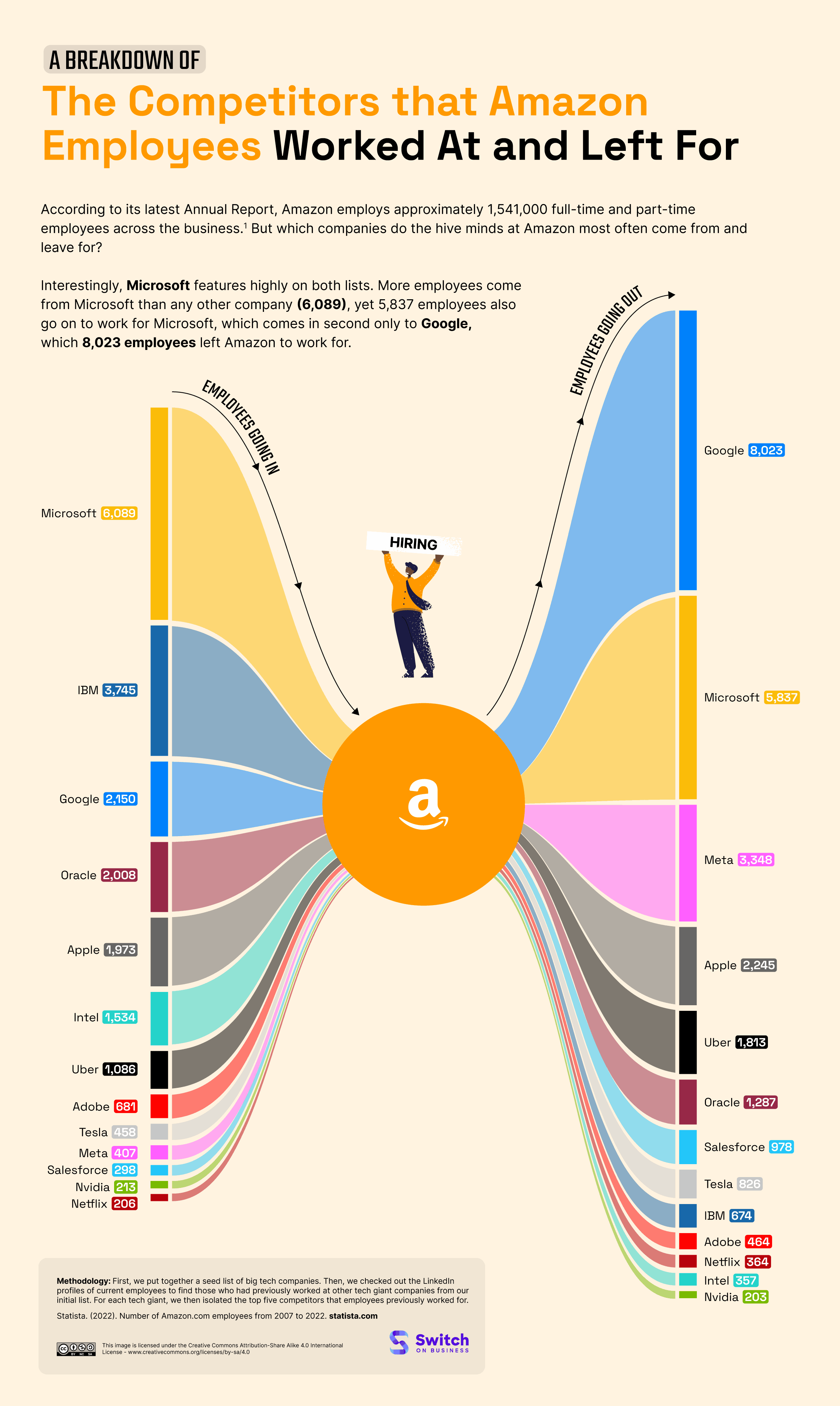
Click here to see the image in full size
Just 3.20% of Amazon’s workforce arrived via a big tech company. Much of Amazon’s workforce is fulfillment or customer service-based (to the extent that the company is actually in danger of “running out of people to hire,” according to Vox), and the nature of this work does not require tech experience. However, among the thousands of big tech job-hoppers that Amazon does hire, the largest share both comes from and leaves to Microsoft. One reason is that the company’s headquarters are just 12 miles apart — emphasizing the importance of a non-disruptive transition for new recruits. Since both companies began laying off thousands of employees on the same day early in 2023, the northwest could be a good place for other firms to go hunting for tech talent.
Apple Covets Intel’s Talent, Not Its Chips
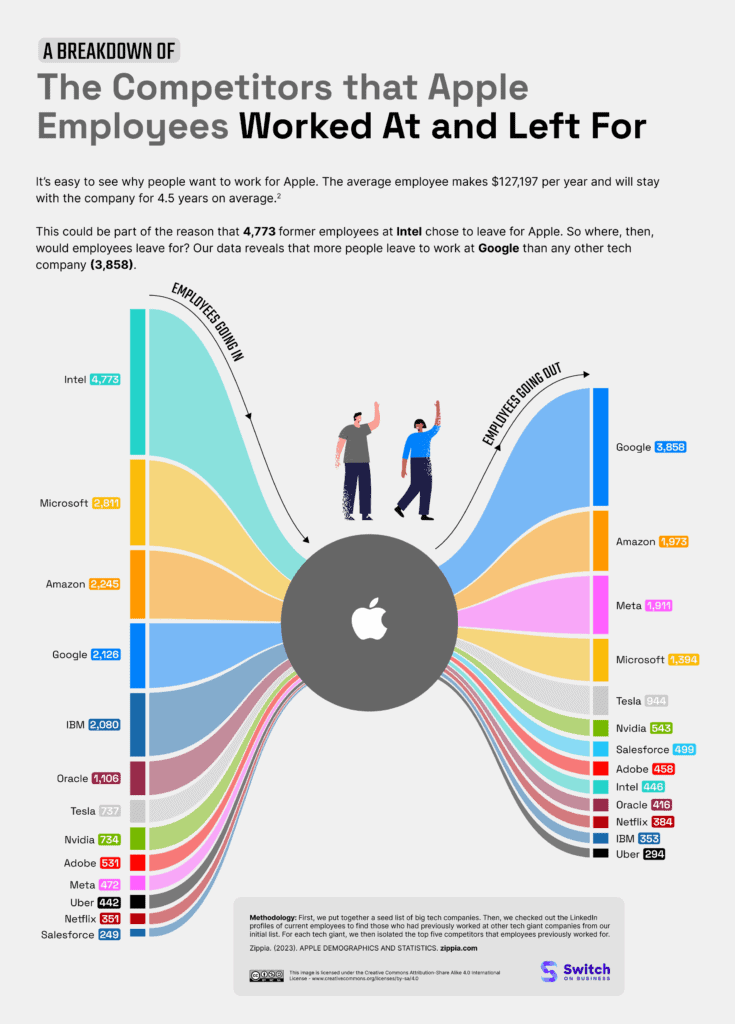
Click here to see the image in full size
Apple’s biggest hunting ground is Intel, a company with which they formerly had a close relationship. Until recently, Apple used Intel chips in its desktop and laptop computers, but the company has long had the intention of developing its own chips — and the company now believes it has edged ahead in designing and manufacturing computer parts. Apple also bought Intel’s modem division, which came with 2,000 former Intel employees and further strengthened the case for other Intel veterans hoping for a shot at an Apple job. Apple has its fair share of ex-Google employees, not least due to hiring Google Maps developers for its own map applications.
Ex-Microsoft Employees Join Google in Their Thousands
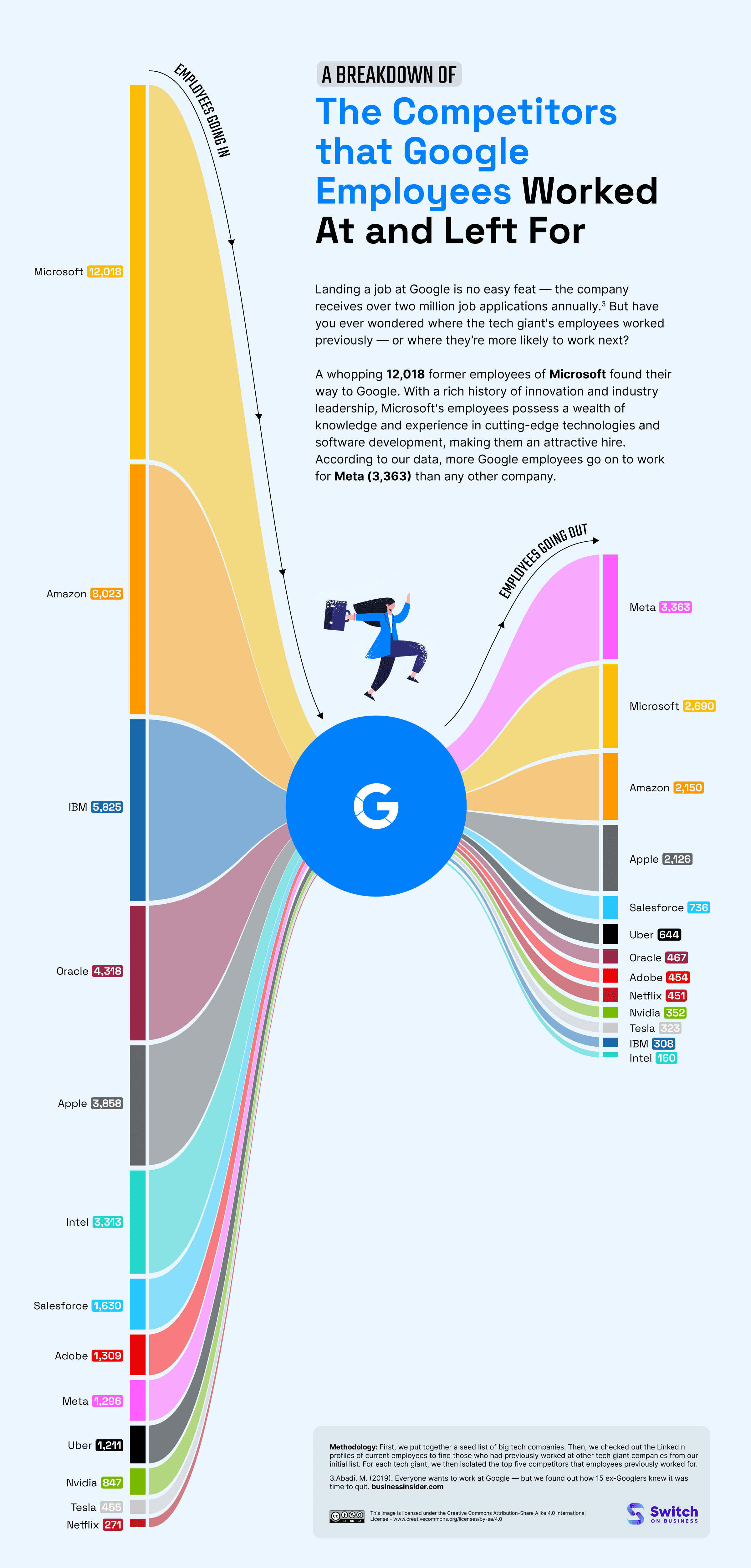
Click here to see the image in full size
With Google laying off hundreds of recruiters, Microsoft’s workers may be wondering where to go instead. Some 12,018 former Microsoft employees currently work for the search and data giant. And while Google seems unlikely to recruit on a grand scale any time soon, those tech boffins they do seek could be more likely to come from the direction of their other AI rivals, OpenAI — a process that has already started. Google is, in turn, losing AI talent to Apple.
Ex-Meta Employees Leave Big Tech Altogether
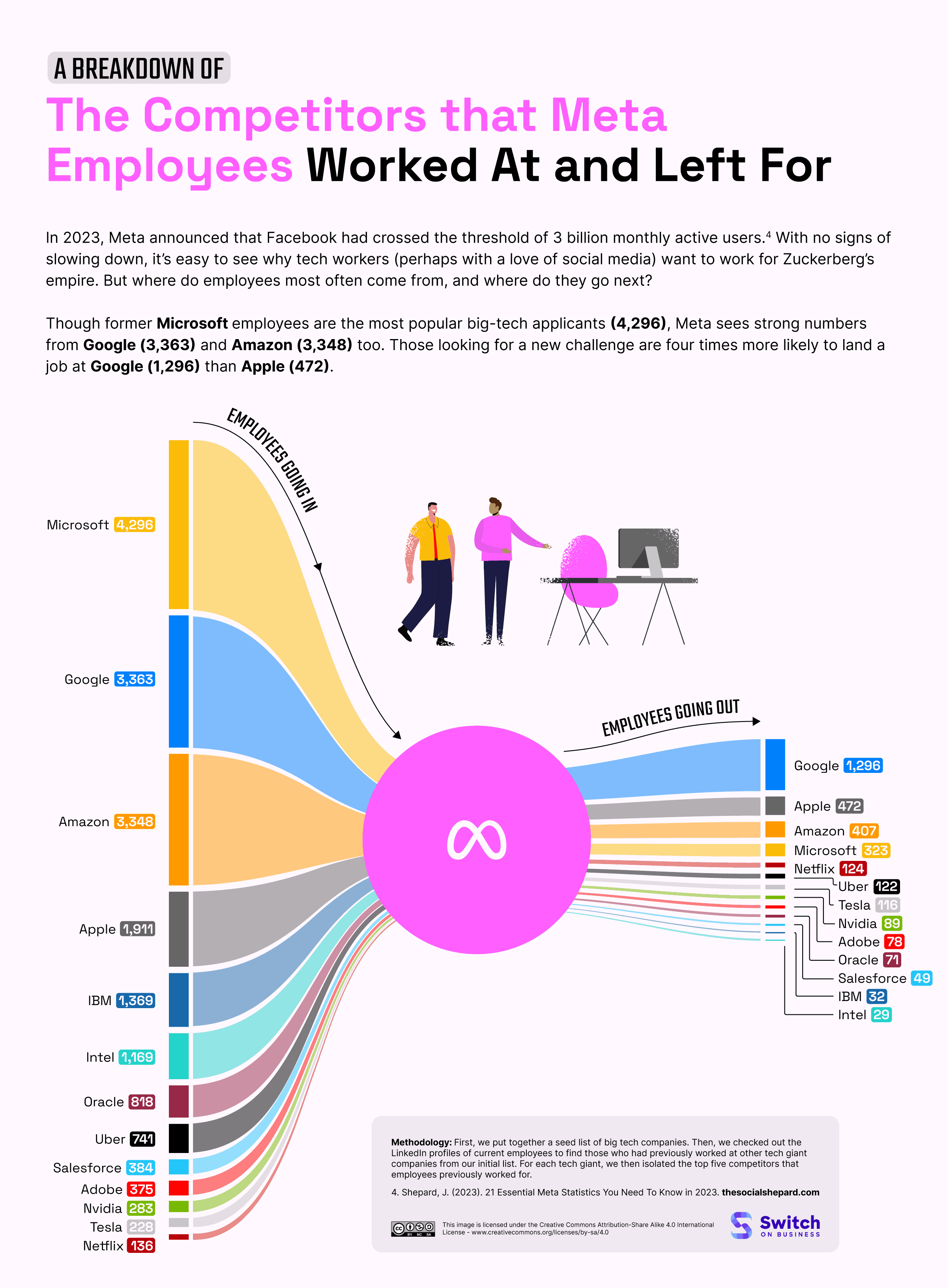
Click here to see the image in full size
Relatively few Meta employees go on to work at the other tech giants, the fewest among the five companies that we’ve profiled in these diagrams. It probably doesn’t help that Meta has given thousands of employees “subpar reviews,” which may not be visible to potential employers but must certainly be discouraging for the recipients. Perhaps they are driven to follow many of the thousands of recently laid-off tech workers out of the sector altogether and into tech roles at banks or healthcare providers where they might be better appreciated.
Microsoft Adopts Ex-IBM Tech Talent
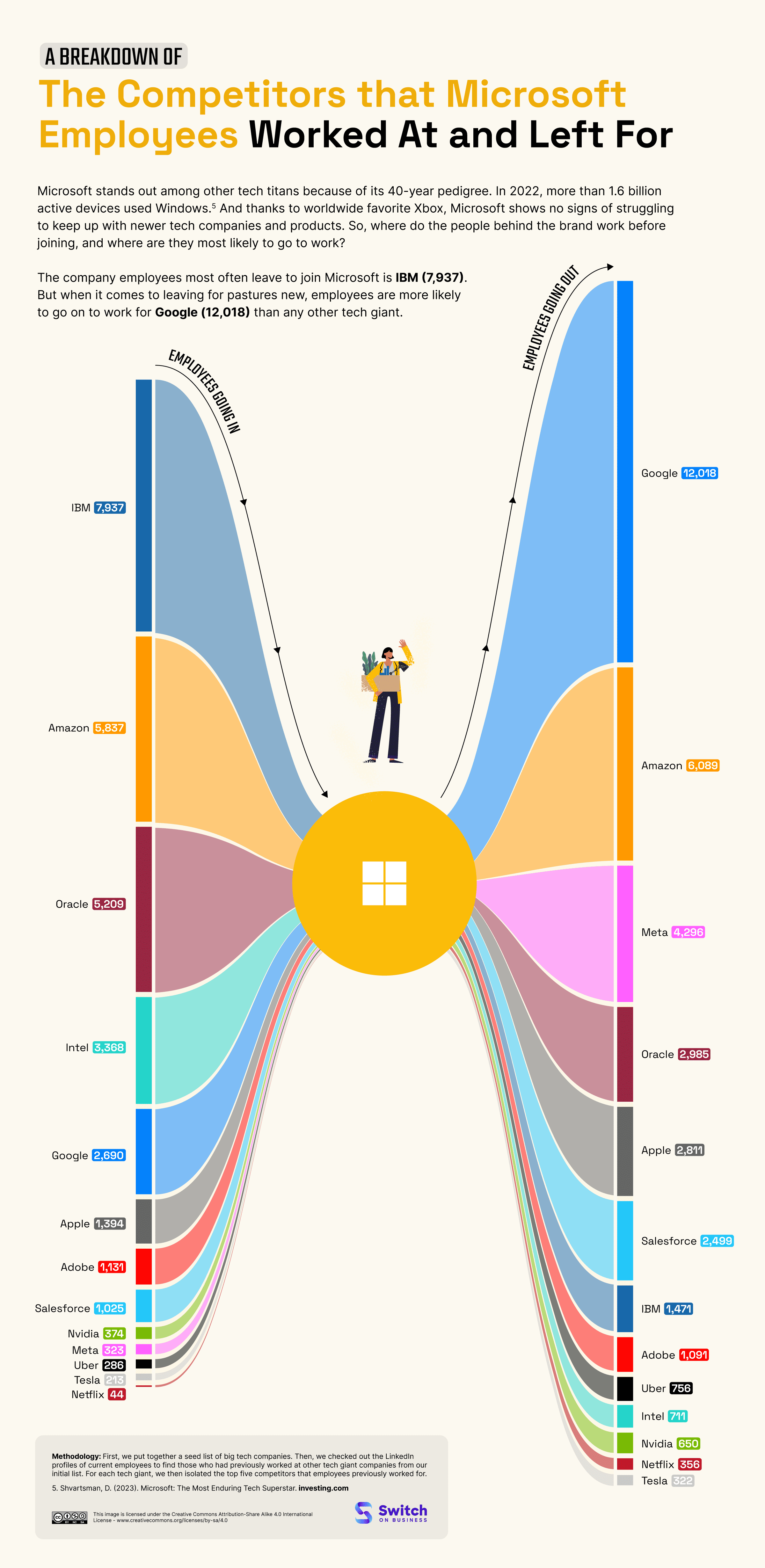
Click here to see the image in full size
At nearly half a century old and presently employing 221,000 people worldwide, it’s no surprise that Microsoft has seen so much talent walk in from — or out to — the other big tech firms. IBM is over a century old, with even more employees, and many of them are likely to find their way to Microsoft, judging by past trends, although relatively few make the opposite journey. Both companies have a complex portfolio of interests, and although each has a different emphasis, there is a large degree of overlap. This makes job-hopping between them an interesting proposition for employees and employers alike, which has apparently resulted in some strictly enforced non-compete clauses for some defectors.
Recruiting Tech Talent in a Crisis
The job market has been in turmoil since the pandemic — and recruitment in the tech sector, even more so. AI is making some roles redundant while creating others, and the biggest tech companies are downsizing their workforces to an unprecedented degree to counterbalance years of “vanity” recruitment and hyper-development.
But those who have been laid off are no less talented for it, with some commentators implying that even Meta’s ‘subpar’ employee reports were designed to spur employees to quit and avoid paying out expensive severance packages. This might be a great moment to draw experienced tech talent to your business.
It is worth being aware, however, that the same recruitment practices that lure talent to the big companies may not work for yours. Not just due to scale but due to changing attitudes and expectations among the workforce, who will better respond to an applicant-friendly recruitment process and an emphasis on company culture and employee testimony when considering vacancies.
Be the company that nobody wants to leave, and you’re more likely to attract that talent in the first place — whatever’s on their resume.
Methodology
To find which tech giants attract the most talent from competitors, we explored employee profiles on Linkedin for a selection of tech companies.
First, we searched how many employees currently worked in these companies: Google (Alphabet), Amazon, Apple, Meta, Microsoft, IBM, Tesla, Oracle, Netflix, Nvidia, Salesforce, Adobe, Intel and Uber.
Then, for each pair of companies, we searched for employees who currently work in each tech giant and previously worked for each other company from the seed list.
We then calculated the count and % of current employees at each tech giant who previously worked at other tech giants.
The full data allowed us to provide breakdowns of the most common pathways between tech giants.
Additional Sources
Statista. (2022). Number of Amazon.com employees from 2007 to 2022. statista.com
Zippia. (2023). APPLE DEMOGRAPHICS AND STATISTICS. zippia.com
Abadi, M. (2019). Everyone wants to work at Google — but we found out how 15 ex-Googlers knew it was time to quit. businessinsider.com
Shepard, J. (2023). 21 Essential Meta Statistics You Need To Know in 2023. thesocialshepard.com
Shvartsman, D. (2023). Microsoft: The Most Enduring Tech Superstar. investing.com

Jim Smith says
I think a key reason you don’t see a lot movement from big tech to IBM is compensation. They pay a lot less when factoring the lack of equity at IBM.
Michael Brundage says
You should use this same dataset to study “boomerangs”: Which Big Tech companies have the largest number of employees who return at some point in the future?
SevenClean says
Too right, this is gold! Thanks for sharing.
sahne perdesi says
I like the efforts you have put in this, regards for all the great content.